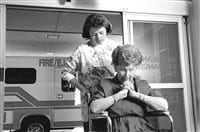Proceeding With Caution Clot-busting Drugs Are Linked To Increased Mortality In The Elderly
The medications known as ‘clot-busting’ drugs used in the treatment of heart-attack victims, while they have proven to be effective in younger people, may be dangerous and even deadly for the very elderly.
According to a Harvard Medical School study published in March in Archives of Internal Medicine, researchers found that heart attack victims in their 80s and 90s have a 40{06cf2b9696b159f874511d23dbc893eb1ac83014175ed30550cfff22781411e5} greater chance of death by strokes and other vessel-related conditions after taking the drugs than had they not received the treatment, called thrombolytic therapy.
“This is strongly suggestive of a problem. We believe that these drugs are more likely to cause bleeds and hemorrhagic strokes in older patients,” said Stephen Soumerai, professor of Ambulatory Care and Prevention at Harvard Medical School and Harvard Pilgrim Health Care and the lead author of the study.
Not for Everyone
More and more heart attack patients are receiving thrombolytic therapy as a result of studies showing that the clot-busting drugs can reduce the risk of dying. But the new study led by Harvard Medical School researchers adds to the growing body of evidence that thrombolytic drugs may increase the overall risk of death for some patients, particularly the oldest and those with certain medical conditions or histories.
The results suggest that national guidelines on the use of these drugs — such as streptokinase and tissue plasminogen activator (t-PA) — should be applied with greater selectivity, and possibly revised, to maximize benefit and minimize risk due to bleeding or stroke, Soumerai said.
The researchers examined records of 2,659 patients with acute myocardial infarction admitted to 37 Minnesota community hospitals from 1992 to 1996. Of this group, 719 patients were eligible for thrombolytic therapy according to the guidelines, which rely on time from symptom onset (under 12 hours), electrocardiograph readings, and absence of contraindications such as trauma, bleeding, or extremely high blood pressure.
In the study, about 63{06cf2b9696b159f874511d23dbc893eb1ac83014175ed30550cfff22781411e5} of eligible patients and 14{06cf2b9696b159f874511d23dbc893eb1ac83014175ed30550cfff22781411e5} of ineligible patients received the drugs. Thrombolytic therapy was associated with reduced mortality among eligible patients younger than 80 years but with increased mortality in older patients.
Among eligible patients 80 to 90 years old, those who got the drugs had an estimated 40{06cf2b9696b159f874511d23dbc893eb1ac83014175ed30550cfff22781411e5} greater risk of death in the hospital compared with patients who did not receive the drugs. For ineligible patients, use of the drugs increased the risk of death regardless of age. For the entire patient group (age 65-plus), the risk of death associated with thrombolytic therapy rose 4{06cf2b9696b159f874511d23dbc893eb1ac83014175ed30550cfff22781411e5} for each year of age.
There are several reasons why elderly patients may not share the benefits of thrombolytic therapy seen in younger patients. The elderly are more likely to have contraindications, their risks for bleeding and stroke are markedly increased, and they tend to experience longer delays between symptom onset and hospitalization that substantially reduce the drugs’ effect on survival.
Of the patients in the study who got thrombolytic therapy, 38{06cf2b9696b159f874511d23dbc893eb1ac83014175ed30550cfff22781411e5} had contraindications. This suggests that heart attack patients in typical practice settings are not as carefully selected for thrombolytic therapy as patients in trials — a problem that commonly frustrates the smooth transition of treatments from clinical trials into community practice.
“The oldest patients, even those without contraindications to therapy, experienced an excess risk of mortality compared with untreated patients,” the authors wrote. “Findings of this study suggest a need to reassess our approach to the use of thrombolytic therapy in the treatment of acute myocardial infarction patients older than 75 years.”
Further Evidence
A study from John Hopkins University, published in the May 16, 2000 Circulation, produced similar results: patients over age 75 who received thrombolytic drugs were nearly 40{06cf2b9696b159f874511d23dbc893eb1ac83014175ed30550cfff22781411e5} more likely to die within 30 days than patients not receiving the drugs.
“Many doctors have been hesitant to prescribe thrombolytic therapy for the oldest patients with myocardial infarction, despite guidelines that strongly promote the therapy for patients of all ages,” Soumerai said. “Our findings, along with those of the earlier study, really seem to justify their concerns.”
Jerry Gurwitz, a professor of medicine at the University of Massachusetts Medical School in Worcester and a co-author of the latest study, said called the findings a red flag to physicians.
“They should avoid using clot-busting drugs in very elderly patients with any risks of serious side effects, such as a prior stroke or a bleeding condition,” he said. “And when they do use them, they need to be dosed and monitored appropriately.”
Co-authors of the study include two of Soumerai’s colleagues in the HMS/HPHC Department of Ambulatory Care and Prevention: assistant professor Thomas McLaughlin and associate professor Dennis Ross-Degnan, along with collaborators from Boston University School of Public Health and the UMass Medical School. The study was funded by the National Institute on Aging of the National Institutes of Health.
The authors recommend that alternative treatments for elderly patients, such as primary coronary angioplasty, be further evaluated.
Much of the information in this article is courtesy of Harvard Medical School.


Comments are closed.